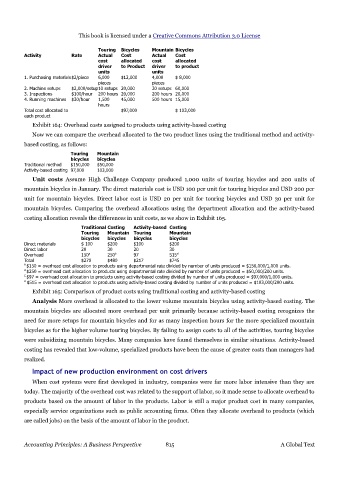Page 814 - Accounting Principles (A Business Perspective)
P. 814
This book is licensed under a Creative Commons Attribution 3.0 License
Touring Bicycles Mountain Bicycles
Activity Rate Actual Cost Actual Cost
cost allocated cost allocated
driver to Product driver to product
units units
1. Purchasing materials$2/piece 6,000 $12,000 4,000 $ 8,000
pieces pieces
2. Machine setups $2,000/setup10 setups 20,000 30 setups 60,000
3. Inspections $100/hour 200 hours 20,000 200 hours 20,000
4. Running machines $30/hour 1,500 45,000 500 hours 15,000
hours
Total cost allocated to $97,000 $ 103,000
each product
Exhibit 164: Overhead costs assigned to products using activity-based costing
Now we can compare the overhead allocated to the two product lines using the traditional method and activity-
based costing, as follows:
Touring Mountain
bicycles bicycles
Traditional method $150,000 $50,000
Activity-based costing 97,000 103,000
Unit costs Assume High Challenge Company produced 1,000 units of touring bicycles and 200 units of
mountain bicycles in January. The direct materials cost is USD 100 per unit for touring bicycles and USD 200 per
unit for mountain bicycles. Direct labor cost is USD 20 per unit for touring bicycles and USD 30 per unit for
mountain bicycles. Comparing the overhead allocations using the department allocation and the activity-based
costing allocation reveals the differences in unit costs, as we show in Exhibit 165.
Traditional Costing Activity-based Costing
Touring Mountain Touring Mountain
bicycles bicycles bicycles bicycles
Direct materials $ 100 $200 $100 $200
Direct labor 20 30 20 30
Overhead 150 a 250 b 97 515 d
Total $270 $480 $217 $745
A $150 = overhead cost allocation to products using departmental rate divided by number of units produced = $150,000/1,000 units.
B $250 = overhead cost allocation to products using departmental rate divided by number of units produced = $50,000/200 units.
C $97 = overhead cost allocation to products using activity-based costing divided by number of units produced = $97,000/1,000 units.
D $515 = overhead cost allocation to products using activity-based costing divided by number of units produced = $103,000/200 units.
Exhibit 165: Comparison of product costs using traditional costing and activity-based costing
Analysis More overhead is allocated to the lower volume mountain bicycles using activity-based costing. The
mountain bicycles are allocated more overhead per unit primarily because activity-based costing recognizes the
need for more setups for mountain bicycles and for as many inspection hours for the more specialized mountain
bicycles as for the higher volume touring bicycles. By failing to assign costs to all of the activities, touring bicycles
were subsidizing mountain bicycles. Many companies have found themselves in similar situations. Activity-based
costing has revealed that low-volume, specialized products have been the cause of greater costs than managers had
realized.
Impact of new production environment on cost drivers
When cost systems were first developed in industry, companies were far more labor intensive than they are
today. The majority of the overhead cost was related to the support of labor, so it made sense to allocate overhead to
products based on the amount of labor in the products. Labor is still a major product cost in many companies,
especially service organizations such as public accounting firms. Often they allocate overhead to products (which
are called jobs) on the basis of the amount of labor in the product.
Accounting Principles: A Business Perspective 815 A Global Text

